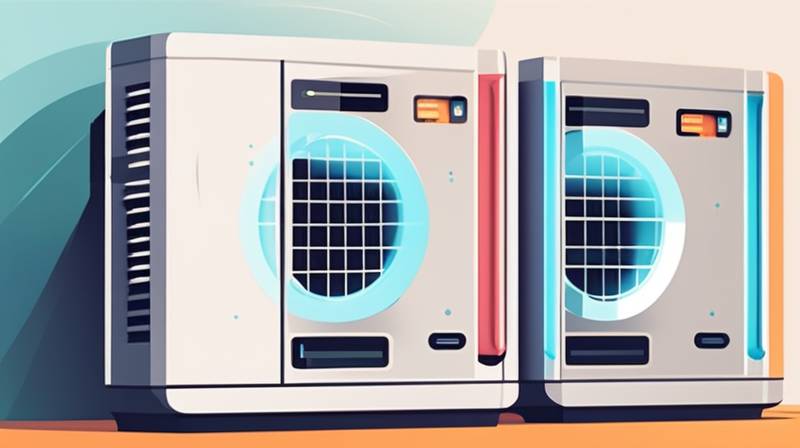
1. The installation of energy storage air conditioning systems generally ranges between $3,000 and $15,000 per unit, depending on specifications and regional market conditions, 2. operational costs may fluctuate based on energy tariffs and system efficiency, 3. potential subsidies or incentives can significantly reduce initial investment, and 4. long-term savings on energy bills will vary but show promise for numerous consumers.
Energy storage air conditioning systems represent an innovative approach to climate control, providing flexibility when energy is consumed. These systems function by utilizing excess energy, which can be stored and subsequently deployed during peak energy demand times, ultimately leading to financial savings and reduced strain on the electrical grid. Key considerations impacting the total expenditure include installation fees, equipment quality, and financing options available.
1. UNDERSTANDING ENERGY STORAGE AIR CONDITIONING SYSTEMS
Energy storage air conditioning technology is ingenious, combining air conditioning units with energy storage capabilities. At its core, this technology allows units to harness and store energy during low-demand periods, only to release it during peak times when energy costs are typically higher. This mechanism reduces costs and enables efficient energy utilization, contributing to environmental sustainability efforts.
The necessity for such systems emerges from increasing energy costs and the environmental impact of traditional air conditioning methods. With escalating demand for cooling solutions, especially in regions prone to extreme heat, energy storage air conditioning offers a solution that not only meets user comfort but also addresses economic and environmental concerns.
2. INITIAL INVESTMENT AND OPERATIONAL EXPENSES
The preliminary financial outlay for installing an energy storage air conditioning system can vary significantly. Factors influencing this include the size of the unit, local installation rates, and the complexity of the setup. The average price range often lies between $3,000 and $15,000, influenced by the type of storage technology utilized—be it traditional batteries, thermal storage, or innovative solutions such as phase change materials.
Installation costs reflect various components, including the unit itself, additional equipment necessary for energy management, and the expertise of HVAC professionals. Specific regions may also present unique costs related to local regulations or utility incentives that can offer financial help for adopting energy-efficient technologies.
3. LONG-TERM SAVINGS AND MUNICIPAL INCENTIVES
Investing in energy storage air conditioning can generate substantial savings over time. By tapping into lower energy rates during off-peak hours, consumers can reduce their electricity bills significantly. The potential for savings increases when considering long-term trends in energy inflation and enhanced efficiency offered by energy storage systems.
Additionally, numerous municipalities and regional authorities incentivize energy-efficient upgrades through rebates, tax credits, or low-interest financing options. Understanding the available programs might significantly reduce the initial financial commitment necessary for acquiring energy storage air conditioning systems. These programs often encourage residential and commercial users’ transition toward environmentally responsible practices, further enhancing the economic appeal.
4. FINANCING OPTIONS AND RETURN ON INVESTMENT
Considering the substantial initial investment, several financing alternatives exist that can ease the financial burden of adopting energy storage air conditioning systems. Home equity loans, personal loans, and dedicated energy financing programs provide avenues through which consumers may secure the necessary funds for installation.
Calculating the return on investment (ROI) for energy storage air conditioning involves analyzing the combination of energy cost savings, enhanced property value due to energy efficiency improvements, and the positive environmental impact achieved through lesser energy consumption. A thorough review of local energy rates and potential savings will provide valuable insight into the timeframe required to recover the initial financial output.
FAQs
WHAT IS ENERGY STORAGE AIR CONDITIONING?
Energy storage air conditioning integrates traditional cooling technology with systems that store energy. This allows the accumulation of energy during off-peak hours, which can be utilized during peak usage times. The strategy minimizes costs by capitalizing on lower rates and reduces the demand on local energy grids. Various technologies can enable this function, including battery systems and thermal energy storage, with each having unique benefits and considerations regarding efficiency, durability, and upfront costs.
HOW DOES ENERGY STORAGE AIR CONDITIONING SAVE ME MONEY?
The primary mechanism through which energy storage air conditioning provides savings lies in its ability to utilize cheaper energy during off-peak hours. By storing energy when demand and costs are lower, consumers can avoid the higher prices associated with peak energy usage. Furthermore, with energy efficiency improvements combined with potential municipal incentives, the net savings can be substantial over time, decreasing overall utility expenses and enhancing financial stability.
ARE THERE ANY SUBSIDIES OR INCENTIVES AVAILABLE FOR ENERGY STORAGE AIR CONDITIONING?
Various organizations, including local governments and utility companies, may offer rebates or tax incentives for energy-efficient home improvements. These programs encourage the adoption of technologies that can significantly lessen the overall impact on the energy grid, particularly when demand is high. It’s crucial for potential purchasers to research available funding options specific to their location, which can dramatically decrease the initial investment necessary for energy storage air conditioning systems.
Investing in energy storage air conditioning systems stands as a forward-thinking strategy for achieving enhanced energy efficiency and financial savings. As residential and commercial energy consumption patterns evolve, the necessity for smarter technologies continues to gain importance. By embracing energy storage, homeowners and businesses not only prepare for fluctuating energy markets but also contribute positively to environmental sustainability efforts. Careful planning and thorough research into available incentives, financing options, and technology choices can lead to a robust, long-term return on investment. Furthermore, staying informed about advances in energy storage technology can empower consumers to make educated decisions tailored to their specific energy needs and budgetary constraints.
Original article by NenPower, If reposted, please credit the source: https://nenpower.com/blog/how-much-does-energy-storage-air-conditioning-cost/


